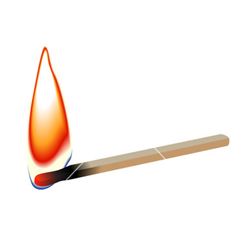
LIGHTING THE FIRE
There are several ways to light a fire, but in all of them you have to be careful about what you burn on your stove. Never use painted or impregnated wood, or plastics that contain chlorine, such as PVC. These materials can produce highly toxic gases. Do not use wood rescued from the sea as it contains salt which can also emit chlorine when burned.
Firewood stored in cold places should remain inside the room for at least a day before being used. The ideal firewood for starting a fire should be split into pieces 4 cm in diameter. This simplifies lighting and will make it easier for the chimney’s natural draft to start sooner.
Before lighting the fire, all dampers must be opened; some stoves have one, others have two. The easiest way to light a fire is as follows:
1. Place two logs on the base of the stove and place several layers of firewood on top, until you reach the secondary air inlets. End up with one full-sized log on top of all the others.
2. Place 2-3 lighter envelopes or similar just below the last layer of firewood, and light it.
3. Under normal firing conditions, you can close the door of your stove, and the fire will start by itself.
Another good idea is to place two logs on either side of the firebox. Put some balls of paper between them and stack firewood on top. You can add more paper if necessary. You will need to ensure that the fire receives sufficient air supply for 10-15 minutes, depending on the draft you need to reinforce the air supply by opening the door ajar.
Add fuel to the stove frequently, small amounts at a time. If the fire is too intense, the thermal stress of the chimney may be unnecessarily high. Burn fuel sparingly. Avoid letting the fire smolder, since this is when more emissions are produced. The best results are obtained when the flame is stable and the smoke from the chimney is imperceptible.